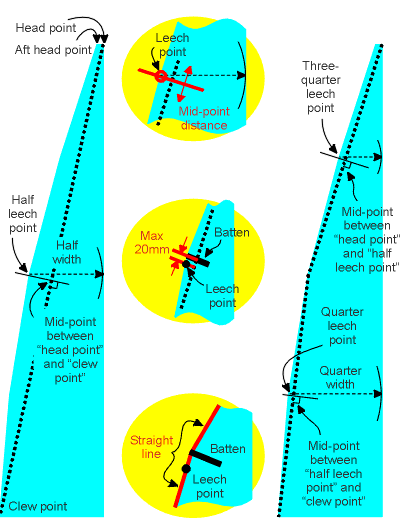
|
|

I've been measuring a number of rigs recently, and discovered that I was having problems with some well known sail makers' sails. After a few seconds' jubilation at finally finding a set of sails that didn't measure from a "big name" supplier, it slowly dawned on me that it was rather more likely to be a problem with my faulty measurement than their faulty product. It turned out that I wasn't applying the Equipment Rules of Sailing properly. The specific issue was that I thought the quarter width of the sail wasn't conforming to the required value, and also that the sail seemed to have its quarter-leech point in the wrong place on the leech. It turned out that I mistakenly thought the quarter-leech point corresponded to a quarter of the distance between the head point and the clew point. Wrong! The quarter and three-quarter leech points are in a quite different place, at the mid-point between the half leech point and the clew or head point as required, projected at right angles back to the leech. The quarter and three-quarter widths are then measured as the shortest distance to the luff. Jan Dejmo comments that finding measurement points at 90 degrees to imaginary
lines can produce mistakes and misunderstandings. The actual definition of
the quarter leech point, for example, is "the point on the leech
equidistant from the half leech point and the clew point". He
suggests finding the leech points in a particularly simple and straightforward
way: just fold the leech: The half leech point is found by folding the head point to the clew point and equally tensioning the two halves of the leech so formed. The half leech point is the intersection of the fold and the leech. Similarly, the quarter and three-quarter points are found by folding the clew point and the head point respectively to the half leech point. The required points are the respective intersection of the folds and the leech. Of course, do this over a rod if you want to continue to be friends with the owner... The battens must be within 20 mm of their relevant leech point. Then, the leech is required to be a straight line between the battens, clew point, and aft head point. The position of a batten is taken through the centre-line of the batten at the point where it intersects the leech. On the IOM main, it is mandatory to have three battens. (In the draft new IOM rules, if you prefer you can have a batten pocket instead of, or in addition to, a batten on the mainsail.) It is completely irrelevant where the panel seams are (except, of course, that a seam must be 150 mm or more away from any sail corner). The ERS 2001-2004 can be found on the ISAF Web site. It is an Adobe PDF file. 2005-12-18 |
|
©2025 Lester Gilbert |